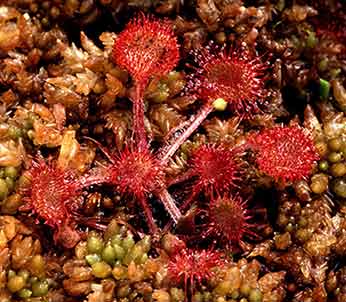Sundews:
Round-leaved sundew
Oblong-leaved sundew
Great sundew
(Drosera rotundifolia, Drosera intermedia, Drosera anglica)
When: Flowering period: June - August
How many:
Round-leaved sundews and oblong-leaved sundews are relatively common and widespread. Great sundews are quite rare.

Sundews are surely the most interesting plants to be found in the New Forest, for they are ferocious, insectivorous beasts that supplement the meagre nutrients found in the acid, wetland soils by absorbing minerals from insect prey.
Three sundew species are present in the New Forest: round-leaved sundew, oblong-leaved sundew and the comparatively scarce great sundew. The first two can be differentiated by leaf shape, the third by size.
Found around the margins of wetter heaths and mires, even great sundews, though, are of relatively modest size, and have one, sometimes two, relatively long, un-branched stems bearing fairly inconspicuous white flowers that for much of the time do not open. Height is from 6-25 centimetres (2 ½ - 10 inches).
But it’s the flat, rosette of long-stalked, reddy-coloured sundew leaves that is the most interesting part of the plant, and certainly the most dangerous, for it is these that have evolved to hold tight and absorb unsuspecting midges and other insects foolish enough to land on their sticky surface.
Each leaf boasts a multitude of hair-like tendrils. Those at the margins are quite long, whilst those towards the centre are far shorter. All, though, are tipped by droplets that, just like dew, glisten in the sun, giving these plants their common name.
On contact, insects quickly become ensnared; the surrounding hairs bend towards the victim to prevent escape, and the whole leaf eventually curls over to enclose the unfortunate creature.
The dew drops also act as digestive juices that dissolve the softer parts of the insect’s body before the resultant liquid is absorbed by the plant - a gruesome fate, indeed.
Small insects are the most frequent sundew victims, insects too tiny and without the muscle power to escape. Sometimes, though, craneflies, damselflies and butterflies are trapped by sundews, and feed the plant.
In former times, sundews were thought to posses many powers. The herbalist John Gerard, writing in the late 16th century, referred to physicians who thought: ‘this herbe to be a rare and singular remedie for all those that be in a consumption of the lungs, and especially the distilled water thereof: for as the herbe doth keepe and hold fast the moisture and dew, and so fast, that the extreme drying heate of the sun can not consume and waste away the same; so likewise men thought that heerwith the naturall and lively heate in mens bodies is preserved and cherished’.
Gerard also rather intriguingly noted of sundews that: ‘cattle of the female kinde are stirred up to lust by eating even of a small quantitie’! When distilled with wine, it was also said to have aphrodisiac and strengthening powers in humans, too – which resulted in an alternative name – youthwort.
References:
The Flora of Hampshire: Anne Brewis, Paul Bowman and Francis Rose
The Wild Flowers of Britain and Northern Europe: Richard Fitter, Alastair Fitter and Marjorie Blamey
Reader’s Digest Field Guide to the Wild Flowers of Britain
The Englishman’s Flora: Geoffrey Grigson
The Herball or General Historie of Plantes: John Gerard
More links
Other related links
Search this site

Sadly, 58 animals were killed - 35 ponies, 13 cows, 8 donkeys and 2 sheep, whilst a further 32 were injured - 3 pigs, 9 donkeys, 11 cows and 9 ponies.
(Forty-three accidents occurred in daylight, 15 at twilight and 101 in the dark. Twenty-seven accidents were not reported by the driver involved).
Here's just one horrific example - Three donkeys killed in collision with van at notorious New Forest blackspot (Advertiser and Times)

